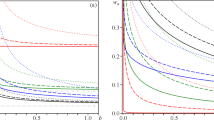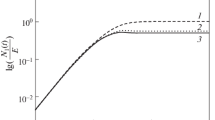A systematic analytical study of the mathematical properties of the previously constructed nonlinear model of the shear flow of thixotropic viscoelastic-plastic media, which takes into account the mutual influence of the deformation process and structure evolution, is carried out. A set of two nonlinear differential equations describing shear at a constant rate and stress relaxation was obtained. Assuming six material parameters and an (increasing) material function that control the model are arbitrary, the basic properties of the families of stress-strain curves at constant strain rates, stress relaxation curves (Part 2) and creep curves (Part 3) generated by the model, and the features of the evolution of the structuredness under these types of loading were analytically studied. The dependences of these curves on time, shear rate, stress level, initial strain and initial structuredness of material (for example, degree of physical crosslinking), as well as on material parameters and function governing the model, were studied. Several indicators of the model applicability are found, which are convenient to check with experimental data. It was examined what effects typical for viscoelastic-plastic media can be described by the model and what unusual effects (properties) are generated by structuredness changes in comparison to typical stress-strain, relaxation and creep curves of structurally stable materials. The analysis proved the ability of the model to describe behavior of not only liquid-like viscoelastoplastic media, but also solid-like (thickening, hardening, hardened) media: the effects of creep, relaxation, recovery, a number of typical properties of experimental relaxation curves, creep and stress-strain curves at a constant rate, strain rate and strain hardening, flow under constant stress, etc. The first part of the article is devoted to formulation of the model and preparation of basis for the second part: the proof of the uniqueness and stability of the equilibrium point of the nonlinear equations set, analytical study of the equilibrium point dependence on all material parameters, possible types of phase portraits and the properties of integral and phase curves of the model.







Similar content being viewed by others
References
J. C. Maxwell, “On the dynamical theory of gases,” Philos. Trans. Roy. Soc. Lond. for the year 1867, 1868. Vol. CLVII. P. 49-88.
E. C. Bingham, Fluidity and Plasticity. McGraw-Hill, N. Y. (1922).
J. G. Oldroyd, “Non Newtonian effects in steady motion of some idealised elastico-viscous liquids,” Proc. Roy. Soc. London. Ser. A., 245, 278-297 (1958).
M. Reiner, Rheology, in: Encyclopedia of Physics, Vol. 6, SpringerBerlin-Heidelberg (1958), 434-550.
P. A. Rebinder, Surface Phenomena in Dispersed Systems. Colloid Chemistry. Nauka, Moscow (1978).
B. D. Coleman, A. Makrovitz, and W. Noll, Viscometric Flows of Non-Newtonian Fluids. Theory and Experiment, Springer, Berlin-Heidelberg-New York (1966).
J. I. Frenkel, Kinetic Theory of Liquids [in Russian], Nauka, Leningrad, (1975).
G. V. Vinogradov and A. Ya. Malkin, Polymer Rheology, [in Russian], Khimiya Publ., Moscow (1977).
E. E. Bibik, Rheology of Disperse Systems [in Russian], LGU, Leningrad (1981).
G. M. Bartenev and Iu. V. Zelenev, Physics and Mechanics of Polymers [in Russian], Vysshaia Shkola Publ., Moscow (1983).
R. G. Larson, Constitutive Equations for Polymer Melts and Solutions, Butterworth, Boston (1988).
N. B. Ur’ev, Physicochemical Fundamentals of Disperse Systems and Materials [in Russian], Khimiya, Moscow (1988).
A. I. Leonov and A. N. Prokunin, Non-Linear Phenomena in Flows of Viscoelastic Polymer Fluids, Chapman and Hall, London (1994).
C. Macosko, Rheology: Principles, Measurements and Applications, VCH, N.Y. (1994).
G. Schramm, A Practical Approach to Rheology and Rheometry, Gebrueder Haake GmbH, Karlsruhe (1994).
C. L. Rohn, Analytical Polymer Rheology, Hanser Publishers, Munich (1995).
R. R. Huilgol, and N. Phan-Thien, Fluid Mechanics of Viscoelasticity, Elsevier, Amsterdam (1997).
R. G. Larson, Structure and Rheology of Complex Fluids, Oxford Press, New York (1999).
R. K. Gupta, Polymer and Composite Rheology. Marcel Dekker, N. Y. (2000).
R. I. Tanner, Engineering Rheology, Oxford University Press, Oxford (2000).
H. Yamaguchi, Engineering Fluid Mechanics (Fluid Mechanics and Its Applications). Springer, (2008).
C. D. Han, Rheology and Processing of Polymeric Material, Vols. 1-2, Oxford University Press, Oxford (2007).
W. W. Graessley, Polymeric Liquids and Networks: Dynamics and Rheology, Garland Science, London (2008).
M. M. Denn, Polymer Melt Processing. Cambridge University Press, Cambridge (2008).
M. Kamal, A. Isayef, and S. Liu, Injection Molding Fundamentals and Applications. Hanser, Munich (2009).
J. L. Leblanc, Filled Polymers, CRC Press, Boca Raton (2010).
A. Y. Malkin and A. I. Isayev, Rheology: Conceptions, Methods, Applications (2nd Ed.). ChemTec Publishing, Toronto (2012).
V. N. Pokrovskii, The Mesoscopic Theory of Polymer Dynamics, Springer (2010).
F. A. Garifullin, Macromolecules and Rheological Equations, Part 1 and 2 [in Russian], KGTU Publ., Kazan (2008).
A. Iu. Altukhov, A. S. Gusev, G. V. Pyshnograi, and K. B. Koshelev, Introduction to the Mesoscopic Theory of Fluid Polymer Systems [in Russian], AltGPA Publ., Barnaul (2012).
A. M. Stolin, A. Y. Malkin, and A. G. Merzhanov, “Non-isothermal processes and methods of investigation in the chemistry and mechanics of polymers,” Russian Chemical Reviews, 48, No. 8, 798-811 (1979).
A. N. Prokunin, “On the non-linear Maxwell-type defining equations for describing the motions of polymer liquids,” J. Appl. Math. Mech., 48, No. 6, 699-706 (1984). doi: https://doi.org/10.1016/0021-8928(84)90037-6.
A. I. Leonov, “Constitutive equations for viscoelasticliquids: formulation, analysis and comparison with data,” Rheology Series, 8, 519-575 (1999).
J. J. Stickel and R. L. Powell, “Fluid mechanics and rheology of dense suspensions,” Annual Review of Fluid Mech., 37, 129-149 (2005).
S. Mueller, E. W. Llewellin, and H. M. Mader, “The rheology of suspensions of solid particles,” Proc. R. Soc. A, 466, No. 2116, 1201-1228 (2010).
A. Ya. Malkin and S. A. Patlazhan, “Wall slip for complex liquids — Phenomenon and its causes,” Advances in Colloid and Interface Sci., 257, 42-57 (2018).
A. M. Stolin, S. I. Khudyaev, and L. M. Buchatskii, “Theory of viscosity superanomaly of structured systems,” Dokl. Akad. Nauk SSSR, 243, 430-433 (1978).
A. M. Stolin and V. I. Irzhak, “Structurally nonuniform flow regimes in the process of polymer fiber formation,” Polym. Sci., 35, No. 7, 990-992 (1993).
N. A. Belyaeva, A. M. Stolin, and L. S. Stelmah, “Modes of firmly-phase extrusion of viscoelastic structured systems,” Inzh. Fiz., No. 1, 10-16 (2009).
Yu. L. Kuznetsova and O. I. Skul’skiy, “Effect of different flows on the shear banding of a liquid with a non-monotonic flow curve,” Appl Mech Tech Phy., 60, No. 1, 22-30 (2019).
T. Divoux, M. A. Fardin, S. Manneville, and S. Lerouge, “Shear banding of complex fluids,” Annual Review of Fluid Mech., 48, 81-103 (2016).
J. F. Brady and J. F. Morris, “Microstructure of strongly sheared suspensions and its impact on rheology and diffusion,” J. Fluid Mech., 348, 103-139 (1997).
C. L. Tucker and P. Moldenaers, “Microstructural evolution in polymer blends,” Annu. Rev. Fluid Mech., 34, 177-210 (2002).
A. Y. Malkin and V. G. Kulichikhin, “Structure and rheology of highly concentrated emulsions: a modern look,” Russian Chemical Reviews, 84, No. 8, 803-825 (2015).
V. G. Kulichikhin and A. Y. Malkin, “The role of structure in polymer rheology: review,” Polymers, 14, 1262, 1-34 (2022). doi: https://doi.org/10.3390/polym14061262.
S. S. Datta, A. M. Ardekani, P. E. Arratia, et al., “Perspectives on viscoelastic flow instabilities and elastic turbulence,” Physical Review Fluids, 7, 080701, 1-80 (2022). doi: https://doi.org/10.1103/PhysRevFluids.7.080701
K. A. Padmanabhan, R. A. Vasin, and F. U. Enikeev, Superplastic Flow: Phenomenology and Mechanics, Heidelberg: Springer-Verlag, Berlin (2001).
D. Fraggedakis, Y. Dimakopoulos, and J. Tsamopoulos, “Yielding the yield stress analysis: A thorough comparison of recently proposed elasto-visco-plastic (EVP) fluid models,” J. Non-Newtonian Fluid Mech., 236, 104-122 (2016).
M. E. Eglit, A. E. Yakubenko, and J. S. Zayko, “Mathematical modeling of slope flows of non-newtonian media,” Proc. Steklov Inst. Math., 300, 219-229 (2018).
S. Varchanis, G. Makrigiorgos, P. Moschopoulos, Y. Dimakopoulos, and J. Tsamopoulos, “Modeling the rheology of thixotropic elasto-visco-plastic materials,” J. Rheology, 63, 4, 609-639 (2019).
A. V. Khokhlov, “Long-term strength curves generated by the nonlinear Maxwell-type model for viscoelastoplastic materials and the linear damage rule under step loading,” J. Samara State Tech. Univ., Ser. Phys. Math. Sci., No. 3, 524-543 [in Russian] (2016). doi: https://doi.org/10.14498/vsgtu1512
A. V. Khokhlov, “Nonlinear Maxwell-type elastoviscoplastic model: General properties of stress relaxation curves and restrictions on the material functions,” Vestn. Mosk. Gos. Tekh. Herald of the Bauman Moscow State Tech. Univ., Nat. Sci., No. 6, 31-55 (2017) [In Russian]. doi: https://doi.org/10.18698/1812-3368-2017-6-31-55
A. V. Khokhlov, “The nonlinear Maxwell-type model for viscoelastoplastic materials: Simulation of temperature influence on creep, relaxation and strain-stress curves,” J. Samara State Tech. Univ., Ser. Phys. Math. Sci., 21, No. 1, 160-179 (2017) (in Russian). doi: https://doi.org/10.14498/vsgtu1524.
A. V. Khokhlov, “A Nonlinear Maxwell-type model for rheonomic materials: stability under symmetric cyclic loadings,” Moscow Univ. Mech. Bull. 73, No. 2. 39-42 (2018). doi: https://doi.org/10.3103/S0027133018020036.
A. V. Khokhlov, “Applicability indicators and identification techniques for a nonlinear Maxwell–type elastoviscoplastic model using loading–unloading curves,” Mech. Compos. Mater., 55, No. 2, 195-210 (2019). DOI: https://doi.org/10.1007/s11029-019-09809-w.
A. V. Khokhlov, “Possibility to describe the alternating and non-monotonic time dependence of Poisson’s ratio during creep using a nonlinear Maxwell-type viscoelastoplasticity model,” Russian Metallurgy, No. 10, 956-963 (2019). DOI: https://doi.org/10.1134/S0036029519100136.
A. V. Khokhlov, “Fracture criteria under creep with strain history taken into account, and long-term strength modeling,” Mech. Solids, 44, No. 4, 596-607 (2009). doi: https://doi.org/10.3103/S0025654409040104.
A. V. Khokhlov, “Properties of the set of strain diagrams produced by Rabotnov nonlinear equation for rheonomous materials,” Mech. Solids, 54, No. 3, 384-399 (2019). DOI: https://doi.org/10.3103/S002565441902002X.
A. M. Stolin and A. V. Khokhlov, “Nonlinear model of shear flow of thixotropic viscoelastoplastic continua taking into account the evolution of the structure and its analysis,” Moscow University Mechanics Bulletin, 77, No. 5, 127-135 (2022). DOI: https://doi.org/10.3103/S0027133022050065.
A. V. Khokhlov, “Equilibrium point and phase portrait of a model for flow of thixotropic media accounting for structure evolution,” Moscow University Mechanics Bulletin, 78, No. 4, 91-101 (2023). DOI: https://doi.org/10.3103/S0027133023040039.
A. V. Khokhlov and V. V. Gulin, “Analysis of the properties of a nonlinear model for shear flow of thixotropic media taking into account the mutual influence of structural evolution and deformation,” Physical Mesomechanics, 26, No. 6, 621-642 (2023). DOI: https://doi.org/10.1134/S1029959923060036.
Acknowledgement
The paper was prepared with the financial support of the Ministry of Education and Science of the Russian Federation as part of the program of the Moscow Center for Fundamental and Applied Mathematics under the agreement № 075-15-2022-284.
Author information
Authors and Affiliations
Corresponding author
Rights and permissions
Springer Nature or its licensor (e.g. a society or other partner) holds exclusive rights to this article under a publishing agreement with the author(s) or other rightsholder(s); author self-archiving of the accepted manuscript version of this article is solely governed by the terms of such publishing agreement and applicable law.
About this article
Cite this article
Khokhlov, A.V., Gulin, V.V. Families of Stress-Strain, Relaxation, and Creep Curves Generated by a Nonlinear Model for Thixotropic Viscoelastic-Plastic Media Accounting for Structure Evolution Part 1. The model, Its Basic Properties, Integral Curves, and Phase Portraits. Mech Compos Mater 60, 49–66 (2024). https://doi.org/10.1007/s11029-024-10174-6
Received:
Revised:
Published:
Issue Date:
DOI: https://doi.org/10.1007/s11029-024-10174-6




